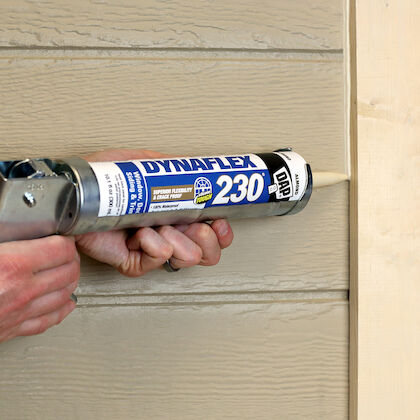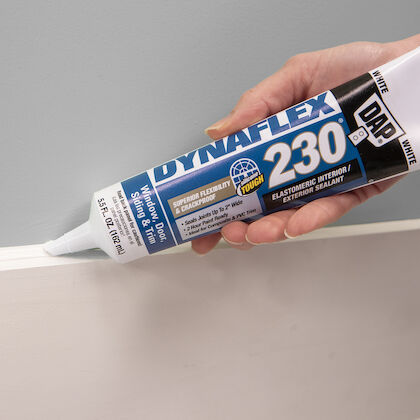Dynaflex 230 is a paintable window & door sealant, while silicone is a versatile sealant used for various applications. Dynaflex 230 and silicone are two popular sealant options; however, they serve different purposes.
Dynaflex 230 is specifically designed as a paintable window and door sealant. It provides a durable seal that is resistant to cracking, peeling, and shrinking.
On the other hand, silicone sealant is a versatile option that can be used for a wide range of applications, including sealing joints, gaps, and cracks in windows, doors, bathrooms, and kitchens.
It offers excellent adhesion, flexibility, and waterproofing properties. Both products have their unique benefits and uses, so it is important to choose the one that suits your specific needs and requirements.
Contents
Composition
The composition of sealants is crucial to understand as it determines their performance and suitability for different applications.
In this section, we will delve into the ingredients of Dynaflex 230 and Silicone sealants to grasp a better understanding of their composition.
Ingredients Of Dynaflex 230
- Silica (Silicon Dioxide)
- Acrylic Resin
- Polyurethane
- Water
- Plasticizers
Ingredients Of Silicone
- Silicone Polymers
- Silica (Silicon Dioxide)
- Curing Agents
- Plasticizers

Flexibility And Durability
When choosing between Dynaflex 230 and Silicone, understanding their flexibility and durability is crucial. These factors determine the performance and longevity of the sealant, particularly in demanding applications.
Flexibility Of Dynaflex 230
Dynaflex 230 exhibits exceptional flexibility, allowing it to accommodate movement and expansion without compromising its sealing capabilities.
Its elastomeric properties enable it to withstand various environmental conditions, including temperature fluctuations and building settling, without cracking or losing adhesion.
Durability Of Silicone
Silicone sealants are renowned for their outstanding durability. They possess remarkable resistance to UV radiation, extreme temperatures, and chemical exposure.
This makes them ideal for outdoor applications and areas prone to constant exposure to harsh elements, maintaining a watertight seal over extended periods.
Application
Dynaflex 230 and Silicone are popular sealant options known for their versatility and durability. Proper application of these sealants is crucial to ensure effective usage and long-lasting results.
Recommended Uses Of Dynaflex 230
- Indoor: Sealing gaps around windows and doors
- Outdoor: Sealing exterior gaps, siding, and trim
- Moisture-prone areas: Bathrooms, kitchens, and basements
Recommended Uses Of Silicone
- High-temperature areas: Around stoves, ovens, and fireplaces
- Wet areas: Showers, baths, and sinks
- Metal, glass, and ceramic surfaces: Creating a water-tight seal

Adhesion
One crucial factor to consider when choosing a caulk for your project is adhesion. The adhesive strength of the caulk determines how well it bonds to different surfaces, ensuring a long-lasting and secure seal.
In this section, we will compare the adhesion strength of Dynaflex 230 and Silicone caulks.
Adhesion Strength Of Dynaflex 230
Dynaflex 230 is renowned for its exceptional adhesion strength. Its advanced formula is specifically designed to adhere to a wide range of materials including wood, metal, concrete, and more.
Whether you are working on interior or exterior projects, Dynaflex 230 delivers outstanding adhesion to ensure a durable and reliable seal.
Adhesion Strength Of Silicone
Silicone caulks are also known for their strong adhesion properties. Silicone caulk forms a flexible and waterproof seal, making it suitable for both indoor and outdoor applications.
Whether you need to seal gaps in windows, apply caulking around a bathtub, or seal joints in a shower, silicone caulk provides excellent adhesion to various surfaces.
Both Dynaflex 230 and Silicone caulks offer impressive adhesion strength, making them reliable choices for your sealing needs.
The key is to select the caulk that suits your specific project requirements and surface materials. To help you make an informed decision, let’s take a closer look at the characteristics and application areas of each type of caulk.
Color Options
When choosing between Dynaflex 230 and Silicone, you’ll find an array of color options. These versatile options allow you to match your project’s requirements with ease, offering flexibility and aesthetic appeal.
Whether it’s a vibrant accent or a subtle finish, the range of color options ensures you can achieve the desired look for the task at hand.
Looking for a sealant that not only performs well but also complements the aesthetics of your project? When it comes to choosing between Dynaflex 230 and silicone sealants, one key aspect to consider is the range of colors available.
Both Dynaflex 230 and silicone offer a wide selection of colors, allowing you to find the perfect match for your application.
Available Colors For Dynaflex 230
Dynaflex 230 comes in a variety of colors, ensuring you can find the right shade for your project. Whether you’re working on interior or exterior applications, this sealant offers a range of options to suit your needs.
The available colors for Dynaflex 230 include:
- White
- Clear
- Gray
- Almond
- Beige
- Brown
- Black
- Redwood
- Cedar
- Blue
- Green
With such a diverse palette, you can easily find the right color to match or contrast with your surfaces, whether you’re sealing gaps around windows, doors, or siding.
Available Colors For Silicone
Silicone sealants are known for their durability and flexibility, and they also offer an array of color options. Selecting the correct color can have a significant impact on the overall look of your project.
When it comes to silicone sealants, you have several color choices, including:
- White
- Clear
- Translucent
- Black
- Gray
- Beige
- Aluminum
Whether you’re working on bathroom fixtures, kitchen countertops, or other applications, silicone sealants can easily match the existing color scheme or provide a striking contrast.
In conclusion, both Dynaflex 230 and silicone sealants offer a wide range of color options, ensuring there is a perfect match for any project.
From traditional neutral tones to vibrant hues, you can choose the color that best complements your surfaces. So, why compromise on aesthetics when you have multiple color choices available for your sealing needs?
Weather Resistance
Weather resistance is a crucial factor when choosing between Dynaflex 230 and Silicone sealants.
Performance In Various Weather Conditions For Dynaflex 230
Dynaflex 230 excels in withstanding harsh weather conditions.
- High resistance to UV rays
- Protects against rain, snow, and temperature changes
- Maintains flexibility under extreme weather
Performance In Various Weather Conditions For Silicone
Silicone sealants are known for their weather-resistant properties.
- Resistant to temperature fluctuations
- Excellent durability against UV exposure
- Waterproofing performance in rainy conditions
Cost Comparison
When considering an adhesive for your construction projects, it’s essential to evaluate the cost comparison between Dynaflex 230 and Silicone.
Both of these products offer unique characteristics, and the price points play a significant role in decision-making. Let’s delve into the specifics to help you make an informed choice.
Price Point Of Dynaflex 230
Dynaflex 230, renowned for its superior adhesion and flexibility, is an affordable option for sealing and bonding applications. With a price range that generally falls between $3 to $8 per tube, Dynaflex 230 provides excellent value for its quality, making it a cost-effective choice for various projects.
Price Point Of Silicone
On the other hand, Silicone is recognized for its waterproof properties and durability. However, it tends to be slightly pricier than Dynaflex 230, typically ranging from $5 to $10 per tube. While Silicone offers exceptional performance, its higher cost should be weighed against the specific requirements of your project.

Frequently Asked Questions Of Dynaflex 230 Vs Silicone
Is Elastomeric Caulk Better Than Silicone?
Yes, elastomeric caulk is better than silicone because it offers greater flexibility and durability.
Its ability to stretch and recover makes it ideal for areas prone to movement and weathering. Elastomeric caulk also has excellent adhesion and is paintable.
What Is Dap Dynaflex 230 Used For?
DAP DynaFlex 230 is used for sealing windows, doors, trim, and siding. It is a flexible, waterproof sealant.
What Is The Difference Between Dap And Silicone?
DAP and silicone have different properties. DAP is a type of sealant that is paintable, while silicone is not.
DAP also bonds more effectively to porous surfaces, while silicone is better for nonporous ones. In terms of flexibility, silicone is more durable and resistant to extreme temperatures.
Is Silicone Or Latex Caulk Better?
Silicone caulk is more durable and flexible than latex caulk. It is better for wet areas and outdoor use.
Conclusion
Overall, when comparing Dynaflex 230 and silicone, both have their unique strengths and weaknesses. Consider the specific needs of your project and choose the one that best suits your requirements.
Experimenting with both products might be beneficial to find the perfect solution for your sealing needs.
